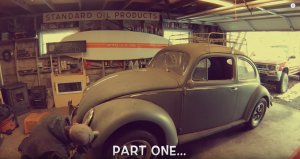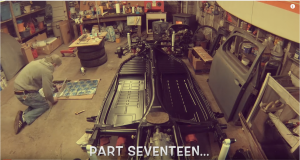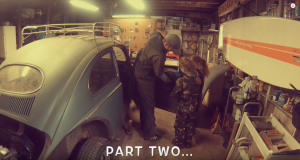Tools Needed:
This step will require some special tools and materials to do it properly. If you plan to tackle another restoration in the future, it’ll be nice to have these tools in your arsenal. If you can afford higher end tools, don’t skimp on these:
- Welder – get a decent welder or borrow one from a friend (for welding in the jack supports). I have a simple flux core wire feed welder that I use for all the sheet metal work – it’s not ideal, but gets the job done. It would be nice to have something better, but they get expensive quick. Of course you’ll also probably want a welding helmet, some dikes/wire cutters, and welding hammer and gloves too.
- Angle Grinder with attachments – an angle grinder is one of the tools I use the most – whether using a cutting blade, wire brush wheel, flap disc, or grinding wheel – you can’t get by without one.. or at least I wouldn’t want to try getting by without one. I have a couple cheap-o grinders that I use all the time. Stock up with a few wire wheels, cutting wheels, and flap discs because you’ll use them.
- Air compressor – an air compressor is also a must for almost all steps in a restoration. Not just painting, but DA sanders, air chisels, sand blasting, etc – I don’t have a fancy one, but I’d invest in the best you can afford. Mine is a simple 20 gallon, but would love to be able to afford a better one.
- HVLP spray gun – for primer, I buy the cheap anodized purple HVLP guns from Harbor Freight – they work great and are very affordable. I have a couple with different tip sizes that I’ve drilled out to handle thicker paint when needed. You won’t want to use these for your final paint job, but for this step I’d suggest buying one.. or two. Along with the spray gun, you probably want a moisture trap and pressure regulator unless you’re brave or just want to take your chances.
- Respirator – get a good respirator with the correct filters for auto paint. I asked my friend who owns a local body shop, but you can ask your local guy since I don’t know much about the filters – just make sure you have the right one so you’re not breathing those fumes.
- Caulk gun – for the seam sealer I use the caulking gun tube type – if you use a brush on seam sealer this isn’t needed.
- Vice grips – I bought a few different vice grips which I also use all the time – get some with a long reach, some with short reach, wide reach, and any other reach you can think of. Something you can use to clamp parts as you weld them so you have a hand free.
- Miscellaneous – for the parts cleaning, I use several size paint scrapers, wire brushes, and a sandblast cabinet. Also get a pack of nitrile gloves that you’ll use all the time. I do it the hard way for a lot of things – there are other ways to clean parts with steam cleaners, solvents, or bringing them to get blasted so I’ll leave these up to you.
Materials/Products Needed:
Now that we’re getting to the stage of putting things back together – we need to make good choices on the products we’re putting on the car; otherwise, we’re just wasting out time. I’ve researched this a lot and there’s always going to be people with different opinions. I came to a decision based on consensus of endless forum posts and videos, and with advice from some friends and the local paint shop. I can only hope that I chose the right products – I guess we’ll see in 10 years if my bug starts to rust!
- Epoxy primer – the primer I used for this project was Lucid Technologies EP 210 which can also be used as a primer sealer
- Chassis paint – for the chassis top coat I used ALK-200 which was recommended by the local shop. I hope it holds up. On my previous restoration I used POR-15 directly over the frame/pans but POR-15 isn’t intended to go over primer. I wanted a “bullet proof” chassis coat – this is what I was told to use. Fingers crossed.
- Phosphoric acid or metal prep – After the frame and parts were thoroughly cleaned (the hard way) – I used klean-strip metal prep to neutralize any surface rust that I wasn’t able to reach or couldn’t see.
- Wax and grease remover – the final step before painting, I used a wax/grease remover to do the final wipe down. I used Omni MX-190 which I also used for my 67 restoration and worked great.
And we’re almost ready for paint!
An important note for this step – if you live in a cold climate, make sure you heat up your garage/paint booth to above 60 degrees and allow time for the metal to be painted to get up to room temperature. I normally don’t leave my pellet stove running in the garage over night, but doing this job in the middle of winter, I left it running for 4 days straight – roughly a day before painting, and two days after to be sure that the epoxy primer and chassis coats fully cured. The garage was the warmest it’s ever been – about 70 degrees! But before getting things clean and ready to paint, I needed to make a little more mess.
Welding in the jack supports:
I began by measuring the placement of the old pan where the jack supports sat. I had written measurements down before cutting the old pans out, so I double checked my measurements with the new pan, and where the old jack supports sat on the pan that I had already cut out. I made a mark on the new pans to center of the jack support and confirmed that the underside of the jack supports were lined up correctly where they would have a good connection to the pan for welding.
I’ll just triple say this – before cutting the old pans out make sure to take measurements of where the body bolt holes are, where jack supports are, where seat belt bolt holes are (if you plan to drill holes through the pans – I don’t plan to but took the measurements anyway) and any measurement you might need with the new pans! There’s no going back once you cut them out. And after cutting the old pans out, don’t throw them away until the end.
Once the marks were made and confirmed, I used the angle grinder with the wire brush to clean the spots where the jack supports would be welded to the pan, getting them down to bare metal on both the pans and also on the jack supports edges where the welds would be made. I used vice grips to clamp the jack stands in position and tack welded them into place. Then I clamped them on the bottom side and tacked those in too until I was sure they were right and lined up. I then finished the welds for the final attachment of the jack stands to the new pans.
Ugh.. cleaning parts
I didn’t bother to video this part, but in between the steps you see in the video, I spent several hours cleaning parts that I will be putting back on the chassis when painting is done. This included the spring plates for the rear suspension, the spring plate covers, front brake drums, all the brake backing plates, front torsion/trailing arms, front access panel cover, and all the nuts and bolts that hold those parts on. Not a fun job but needed to be done.
If you have the money to bring them to a sandblaster that you trust to not ruin parts, go for it. Otherwise, I can tell you how I cleaned the parts the hard way and you can play along.
I started with a paint scraper blade – started scraping all the caked on dirt and grime off the parts. Sometimes it helps to soak them in soapy water and let them sit for a while to make it easier to scrape. This comes in especially handy when trying to clean the transmission and steering box which in my case had about an inch of grease and grime on them. The parts I painted in this video were pretty clean as far as caked on grease, but they required a lot of cleaning to get down to bare metal and prepped for paint.
After scraping all the parts, I then took a wire brush on the angle grinder and got all the places I could reach – outer brake drums, spring plates, backing plates, etc. For the places I couldn’t reach, I then brought them into my blast cabinet (the red box you see in the background of some videos) – without a good air compressor, I had to take my time so I didn’t burn it out, but I eventually was able to get them down to metal and ready for prepping.
Ready to paint
Clean, prep, clean, prep
Excuse my jumping around, but along with the parts cleaning, the same steps were done to the frame. Scraped, wire brushed, sanded, wax and grease remover, phosphoric acid, then a final wipe down with the wax and grease remover wearing gloves. Then it was time to paint.
IMPORTANT NOTE: again, if you’re in a cold climate, before painting with epoxy primer, make sure the temperature is 60+ degrees and you’ve allowed time for the metal to reach room temperature.
First primer
Ok. All parts clean, frame clean, pan clean and ready to prime for paint. I mixed the epoxy primer to the recommended ratios – make sure you get a spec sheet when buying the paint so you know the correct mix. I strained the mixed paint into the gun, set the pressure around 30psi with the moisture trap in place and tested the spray pattern on the plastic hanging down to create my makeshift paint booth. I adjusted the air pressure and dials on the gun until the pattern looked good, then started with a coat of epoxy primer on the frame and pans.
After I got the first coat of primer on the frame and pans top side, I did the final prep on the parts. To prep the freshly blasted/scraped/brushed parts for paint, I took some 180 grit sandpaper and went over them again to remove any debris from blasting/handling. Once they were sanded, I cleaned them thoroughly with the wax and grease remover, then painted them with the phosphoric acid to neutralize any surface rust that, even if I couldn’t see it, knew it was there. After letting the acid do it’s job, I washed them with soapy water again and wiped them down for a final time with the wax/grease remover.
When using the wax and grease remover, I wear nitrile gloves because I’m handling the parts while I clean them – so wearing the gloves will prevent hand prints/grease from remaining on the parts before paint.
I also masked off any areas that I didn’t want painted. This includes the inside of the brake drums where the shoes make contact, the inner bearing races of the drums, the inner torsion/trailing arms (where the needle bearings of the front beam make contact), and the rear torsion arms since these will never be seen, and I’ll just be coating them with grease before re-installing anyway.
Then my camera died.. weird. Missing from the video, but I put a coat of primer on the parts then let it sit for about 45 minutes, and applied another coat of primer over the frame, pans, and parts (one side anyway). The next day – back to what was caught on video, I had my brother come over to help me flip the pan over so I could start on the bottom side. I also flipped all the parts over as you see in the video. The same process was done on the bottom as was done on the top – cleaning and prepping, spraying two coats of primer.
NOTE: If you happen to get a water drop on the paint (primer or top coat) — which happened to me a couple times even when using the moisture trap (I think the pros set the trap near the compressor to avoid this, but hey I’m no pro) — don’t panic. As soon as you see a drip of water on the fresh paint, just stop and dab it with a paper towel. We’re not going for a mirror finish on the chassis, so it’s ok. Dab it and make it as un-noticeable as possible, then continue on to respray the area you dabbed after making sure no water is still under the paint.
Then seam sealer
After letting it sit overnight with the stove cranking, I came back the next afternoon to apply seam sealer to the pans.
SIDE NOTE: you can see in the video – in the morning I applied a coat of high heat black paint to the brake parts – I’m wondering if this was a mistake, but worse, case I’ll take the brake parts back off an paint them again if they don’t hold up — but we’ll see.. hopefully at least a few years from now…
So back to seam sealing… I used a caulk type seam sealer – there’s a brush on type as well, but the caulk type allowed me to be more controlled in my application. I began on the bottom side of the chassis – following the lines where the pans meet the frame. I put a fat bead all along that edge to be sure it filled in the seam – after applying the fat bead of sealer, I went back and smoothed and squished it into all the gaps that I could see. I then ran it along any seams where moisture could possibly get it – including the frame head where the welds were made and any area where two pieces of metal meet – while cleaning the frame, I scraped off a lot of the original seam sealer, so I knew where to replace it, but basically anywhere two panels meet and create a welded seam – fill it and smooth it out.
And finally paint
After letting the seam sealer set – I let it sit for a couple hours, but I think it only takes about 30 minutes before it’s ready to paint. Anyway, after it had set up and was hard to the touch, I was ready to paint the first top coat chassis paint. This paint didn’t require any ratios of reducer/catalyst or anything. Basically just stirred/shook/mixed the paint before straining into the paint gun and painting. It went on smooth – two coats with a flash time between of about 45 minutes. This was done on all the parts as well as the frame and pans.
Make sure you think of all the angles the paint will hit — on the pan, the bottom is easy because it’s basically flat, but try to spray at all angles around the parts to get in all the areas and edges where a straight spray pattern won’t reach. I follow the edges of the circular parts on both sides, changing angles all around the smaller brake parts, etc to be sure I get a good coat all around – it’s annoying to find a missed spot and have to go through all the painting and cleanup again
All in all, I was happy with the way the paint turned out – and seems very strong and as bullet proof as I expected it to be after curing for a few days. Next we’ll top coat the top side of the frame and parts since these are still only in primer. Next video I’ll cover that and installing the new narrowed front beam.



